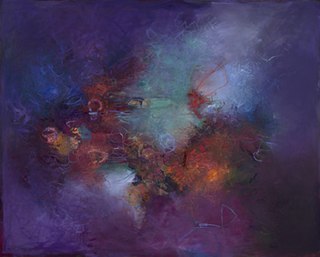
Kenneth Noland was an American painter. He was one of the best-known American color field painters, although in the 1950s he was thought of as an abstract expressionist and in the early 1960s he was thought of as a minimalist painter. Noland helped establish the Washington Color School movement. In 1977, he was honored by a major retrospective at the Solomon R. Guggenheim Museum in New York that then traveled to the Hirshhorn Museum and Sculpture Garden in Washington, D.C., and Ohio's Toledo Museum of Art in 1978. In 2006, Noland's Stripe Paintings were exhibited at the Tate in London.
Abstract expressionism is a post–World War II art movement in American painting, developed in New York City in the 1940s. It was the first specifically American movement to achieve international influence and put New York at the center of the Western art world, a role formerly filled by Paris.

Helen Frankenthaler was an American abstract expressionist painter. She was a major contributor to the history of postwar American painting. Having exhibited her work for over six decades, she spanned several generations of abstract painters while continuing to produce vital and ever-changing new work. Frankenthaler began exhibiting her large-scale abstract expressionist paintings in contemporary museums and galleries in the early 1950s. She was included in the 1964 Post-Painterly Abstraction exhibition curated by Clement Greenberg that introduced a newer generation of abstract painting that came to be known as color field. Born in Manhattan, she was influenced by Greenberg, Hans Hofmann, and Jackson Pollock's paintings. Her work has been the subject of several retrospective exhibitions, including a 1989 retrospective at the Museum of Modern Art in New York City, and been exhibited worldwide since the 1950s. In 2001, she was awarded the National Medal of Arts.

Lenore "Lee" Krasner was an American abstract expressionist painter, with a strong speciality in collage. She was married to Jackson Pollock. Although there was much cross-pollination between their two styles, the relationship somewhat overshadowed her contribution for some time. Krasner's training, influenced by George Bridgman and Hans Hofmann, was the more formalized, especially in the depiction of human anatomy, and this enriched Pollock's more intuitive and unstructured output.

Elaine Marie Catherine de Kooning was an Abstract Expressionist and Figurative Expressionist painter in the post-World War II era. She wrote extensively on the art of the period and was an editorial associate for Art News magazine.
Morris Louis Bernstein, known professionally as Morris Louis, was an American painter. During the 1950s he became one of the earliest exponents of Color Field painting. While living in Washington, D.C., Louis, along with Kenneth Noland and other Washington painters, formed an art movement that is known today as the Washington Color School.

Color field painting is a style of abstract painting that emerged in New York City during the 1940s and 1950s. It was inspired by European modernism and closely related to abstract expressionism, while many of its notable early proponents were among the pioneering abstract expressionists. Color field is characterized primarily by large fields of flat, solid color spread across or stained into the canvas creating areas of unbroken surface and a flat picture plane. The movement places less emphasis on gesture, brushstrokes and action in favor of an overall consistency of form and process. In color field painting "color is freed from objective context and becomes the subject in itself."

Hans Hofmann was a German-born American painter, renowned as both an artist and teacher. His career spanned two generations and two continents, and is considered to have both preceded and influenced Abstract Expressionism. Born and educated near Munich, he was active in the early twentieth-century European avant-garde and brought a deep understanding and synthesis of Symbolism, Neo-impressionism, Fauvism, and Cubism when he emigrated to the United States in 1932. Hofmann's painting is characterized by its rigorous concern with pictorial structure and unity, spatial illusionism, and use of bold color for expressive means. The influential critic Clement Greenberg considered Hofmann's first New York solo show at Peggy Guggenheim’s Art of This Century in 1944 as a breakthrough in painterly versus geometric abstraction that heralded abstract expressionism. In the decade that followed, Hofmann's recognition grew through numerous exhibitions, notably at the Kootz Gallery, culminating in major retrospectives at the Whitney Museum of American Art (1957) and Museum of Modern Art (1963), which traveled to venues throughout the United States, South America, and Europe. His works are in the permanent collections of major museums around the world, including the Metropolitan Museum of Art, Tate Modern, Germanisches Nationalmuseum, National Gallery of Art, and Art Institute of Chicago.
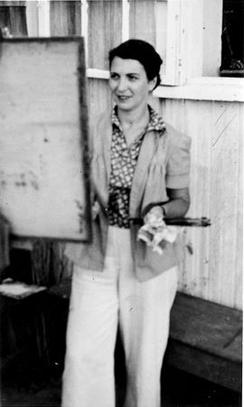
Perle Fine (1905–1988) was an American Abstract expressionist painter. Fine's work was most known by its combination of fluid and brushy rendering of the materials and the use of biomorphic forms encased and intertwined with irregular geometric shapes.
Carol Lorraine Sutton is a multidisciplinary artist born in Norfolk, Virginia, USA and now living in Toronto, Ontario, Canada. She is a painter whose works on canvas and paper have been shown in 32 solo exhibits as well as being included in 94 group shows. Her work, which ranges from complete abstraction to the use of organic and architectural images, relates to the formalist ideas of Clement Greenberg and is noted for the use of color. Some of Sutton paintings have been related to ontology.
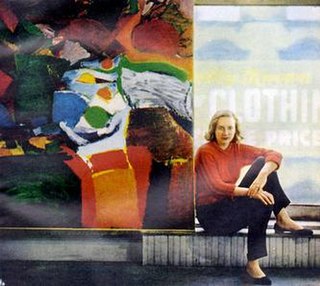
Grace Hartigan was an American Abstract Expressionist painter and a significant member of the vibrant New York School of the 1950s and 1960s. Her circle of friends, who frequently inspired one another in their artistic endeavors, included Jackson Pollock, Larry Rivers, Helen Frankenthaler, Willem and Elaine de Kooning and Frank O'Hara. Her paintings are held by numerous major institutions, including the Museum of Modern Art in New York City. As director of the Maryland Institute College of Art's Hoffberger School of Painting, she influenced numerous young artists.
Hope Gangloff is an American painter based in New York City who is known for her vividly-colored portraiture.

Elizabeth A. T. Smith is an American art historian, museum curator, writer, and presently the executive director of the Helen Frankenthaler Foundation. She has formerly held positions as a curator at the Los Angeles Museum of Contemporary Art (MoCA), the chief curator and deputy director of programs at the Museum of Contemporary Art, Chicago, and the executive director, curatorial affairs, at the Art Gallery of Ontario. She is the author of numerous books on art and architecture, including Blueprints for Modern Living: History and Legacy of the Case Study Houses; Lee Bontecou: A Retrospective, Helen Frankenthaler: Composing with Color, 1962–63, and many others.
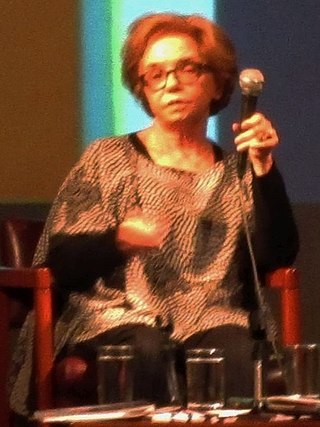
Fanny Sanín Sader is a Colombian born artist from Bogotá who resides in New York City. The daughter of Gabriel Sanín Tobón and Fanny Sader Guerra, she is best known for her paintings of abstract geometric forms and colors. She is considered to be part of the second generation of abstract artists from Colombia.
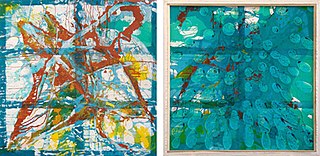
Dona Nelson is an American painter, best known for immersive, gestural, primarily abstract works employing unorthodox materials, processes and formats to disrupt conventional notions of painting and viewership. A 2014 New Yorker review observed, "Nelson gives notice that she will do anything, short of burning down her house to bully painting into freshly spluttering eloquence." Since 2002, long before it became a more common practice, Nelson has produced free-standing, double-sided paintings that create a more complex, conscious viewing experience. According to New York Times critic Roberta Smith, Nelson has dodged the burden of a "superficially consistent style," sustained by "an adventuresome emphasis on materials" and an athletic approach to process that builds on the work of Jackson Pollock. Writers in Art in America and Artforum credit her experimentation with influencing a younger generation of painters exploring unconventional techniques with renewed interest. Discussing one of Nelson's visceral, process-driven works, curator Klaus Kertess wrote, the paint-soaked "muslin is at once the tool, the medium, and the made."
Sigrid Sandström is a Swedish artist and a professor of Painting at the Academy of Fine Arts in Helsinki. Her work is characterized by graphic abstraction, an embrace of color and difference in scale, and an array of techniques used to apply paint and other materials to canvas, ranging from cloths and rugs, to masking with tape, squeegee-ing and smearing, and collaging. She has also worked in film and video, most notably for her 2005 exhibition Her Black Flags at the Mills College Art Museum in Oakland, CA, and in sculpture and installation. Artforum critic Naomi Fry, reviewing a 2007 show at Edward Thorp Gallery, cited the artist's interest in landscape as subject and noted that Sandström "also grapples here with painting’s essential difficulty in the face of the sublime. As the works consistently teeter on the verge of abstraction, the interplay between a more traditional naturalism and geometric fragmentation provides a salient tension."
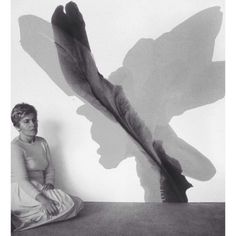
Irene Monat Stern (1932-2010) was a Poland-born American artist who spent her working life in the United States. Known for her abstract paintings, her works have been displayed and collected across the United States; from The Esther-Robles Gallery in Los Angeles, to the Metropolitan Museum of Art in New York, to the Hirshhorn Museum and Sculpture Garden in Washington D.C.'s permanent collection.

Mountains and Sea is a 1952 painting by American abstract expressionist painter Helen Frankenthaler. Painted when Frankenthaler was 23 years old, it was her first professionally exhibited work. Though initially panned by critics, Mountains and Sea later became her most influential and best known canvas.

Charlotte Park, also known as Charlotte Park Brooks (1918–2010) was an American abstract painter. She began work as a professional artist soon after the close of World War II, working in studios first in Manhattan and then in eastern Long Island. She was associated with and drew both support and inspiration from her husband James Brooks and other first-generation abstract expressionist artists, including particularly her neighbors, Jackson Pollock, and Lee Krasner. During most of her career she neither sought nor received praise from critics and collectors, but late in life was celebrated for the quality of her artistic achievements and had her work shown in prestigious solo and group exhibitions. At the end of her life a critic said, "Hers was a major gift all but stifled by a happily embraced domesticity and by the critical bullying of a brutally doctrinaire art world."
Jackie Saccoccio was an American abstract painter. Her works, considered examples of gestural abstraction, featured bright color, large canvases, and deliberately introduced randomness.
